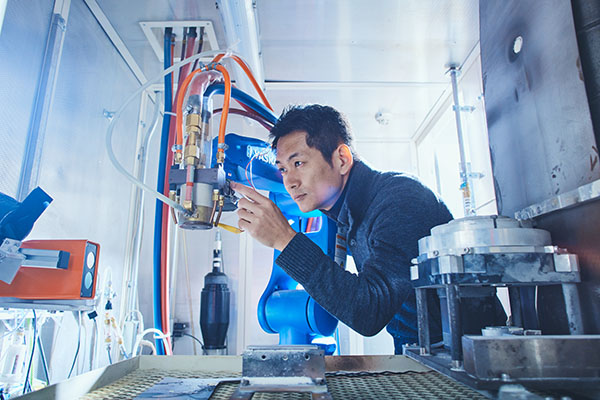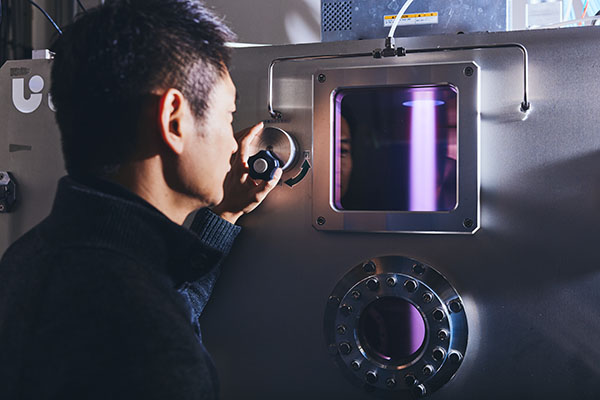Key Points
Creating a film is creating the next world. From stain-resistant toilets to robust infrastructure and low-cost rockets, coatings have infinite possibilities. The aerosol deposition (AD) method, which forms a film by spraying particles at room temperature, is a technology developed by AIST. It presents new design guidelines that expand the range of material choices. We interviewed Shinoda Kentaro, group leader of the Advanced Functional Surface Group, Advanced Manufacturing Research Institute, who received the AIST Paper Award for this research.
What makes this research amazingA breakthrough from basic research that will change the world.
A Japan-originated coating technology attracting attention from European and American companies!
What factors led to this technology gaining attention from the industry?
ShinodaThe adhesion mechanism of the AD method, known as the room-temperature impact consolidation (RTIC), was discovered by Principal Researcher Akedo Jun, co-recipient of this award.
Previously, coating materials in powder form could not be evaluated when the particles were smaller than 1μm. Thanks to our research results, we are now able to quantitatively evaluate each individual particle, and I believe the impact came from our significant progress in elucidating its mechanism.
Since the publication of this paper, we have been hearing from many different fields about the start of similar research. It seems that its impact has spread to areas we once thought were completely unrelated, and the number of people reaching out for consultations has increased.Also, it’s been over 20 years since AIST first introduced the AD method. As the expiration of the basic patent approaches, many countries have been preparing to implement the AD method, and I believe it is significant that AIST has once again demonstrated its leadership in this field. We’ve also developed the next-generation AD method, which we’ve named Hybrid Aerosol Deposition, and I hope to lead the next decade in this area.
What aspects of coating technology research do you find attractive?
ShinodaUntil now, the AD method has primarily advanced technology transfer with a "closed strategy" by keeping process know-how confidential and licensing it to specific companies. Now, with a deeper understanding of the process in various countries, advanced research results are being made worldwide. This shift has allowed us to move towards an open innovation phase, where we accelerate technological development by identifying areas for cooperation. Along with the expectations from industry towards AIST, there is also the pressure of how to maintain technological advancement and leadership.
The appeal of process research, such as coating technology, is that how a single new research finding can completely overturn previous approaches. I can truly feel the significant attention our research is receiving. I’ve been researching the fundamentals of coating since I was a student. The motto of our research group is "Breakthroughs from fundamental research." However, such breakthroughs don’t happen frequently. Basic research often doesn’t seem immediately useful to society, but with this research, I believe we’ve been able to provide a concrete answer by presenting design guidelines based on reliable background data."
Have there been any changes as a result of gaining attention from overseas research institutions and companies?
ShinodaThe most common application of our coating technology is in aircraft manufacturing and development, a field where research by NASA and Western countries has been leading. While the field has been developing mainly in the West, our Japan-originated technology has attracted interest from overseas institutions. As a result, we have been invited abroad for lectures and discussions, so I think it has been recognized internationally.
Additionally, I have felt its influence in new fields that we had no previous connections with. For example, we discussed with researchers studying geological layers whether the deformation of the coating might follow the same mechanism as geological shifts. In fields where research had not progressed due to a lack of evidence, the findings of our paper have served as a concrete starting point for further studies.

I want people like you to know about thisLarge-scale joint research projects with companies utilizing this knowledge are currently in progress.
New groups of companies, including raw material manufacturers and semiconductor equipment/component manufacturers, are showing high interest.
In what fields are projects currently being developed?
ShinodaThe most significant project would be in gas turbine development. For example, in utilizing ammonia, which is gaining attention as a fuel in the carbon-neutral era, it is essential to have coatings that protect systems from corrosion. We are working on development with heavy industry manufacturers. Additionally, in promoting a circular economy, we are advancing projects that use coating technology for repairs as a key element of "remanufacturing." (Refer to AIST Magazine: リマニファクチャリングとは?(What is Remanufacturing?))
This research has resulted in technology that can evaluate raw powder materials for coatings, leading to an increase in inquiries from ceramic raw material manufacturers. We are also receiving more and more inquiries from manufacturers of semiconductor manufacturing equipment and components, for which this technology is indispensable.
In what fields do you expect further development and application in the future?
ShinodaWe have been conducting research on coating technology to strengthen Japan's industrial competitiveness in areas such as materials development, batteries, and semiconductors. Moving forward, we aim to focus on solving social challenges, including tackling energy and environmental constraints through hydrogen, ammonia, and synthetic fuels, as well as contributing to a circular economy and the lifespan of infrastructure through repair technologies. We would like to develop this research in a wide range of field.
While European countries and United States have led research in coating technology for aircraft and medical applications, Japan has now developed its own competitive technology. As a result, overseas companies are paying attention to our technology and working on the AD method. In the field of remanufacturing, there is a high demand for metal repair, which is why AIST has begun research on a metal spray technology called cold spray. This falls under the broader category of kinetic spray technology and we aim to systematize repair technology by leveraging our strengths in both ceramic and metal coating technology.
This is truly a breakthrough originating from fundamental research, and it is changing the way we see the world.
 Watching the plasma coating process
Watching the plasma coating process
In the future, what kind of people would you like to be engaged in this research and how would you like them to be involved?
ShinodaCoating is a niche industry. As Japan’s population continues to decline, it will be crucial for the entire industry to come together and collaborate on future initiatives. Fortunately, in recent years, I have noticed a renewed interest in the coating field, with more heavy industry companies participating in academic conferences.
For example, large corporations could invest in AIST, which would serve as a hub for bridging the gap between technological development for commercialization and academic research. Universities and students could also participate in research, leading to students joining related companies and continuing development efforts. We aim to establish a center for this industry-academia-government collaboration cycle.
AIST has the drive and the network to make this happen, so we hope to involve people from all sectors—industry, academia, and government.
If you are interested in this research, please feel free to contact us.